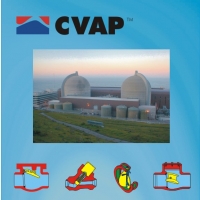CVAP®—Check Valve Analysis and Prioritization Software
The CVAP computer program quantifies the rate of degradation of check valve internals, including hinge pin wear and disc stud fatigue, and is used to prioritize valve maintenance, diagnose problems, and improve reliability. It is capable of analyzing swing, tilt, double-disc, and lift check valves. CVAP methodology has been used to analyze thousands of check valves in U.S. nuclear power plants, and has been called a “model” for the industry by INPO.
Benefits of CVAP valve analysis include:
- Identify problem valve installations
- Quantify levels of valve degradation
- Characterize check valve performance
- Prioritize maintenance and inspection activities
- Reduce inspection of properly functioning valves
- Enhance effectiveness of non-intrusive examination
- Create a check valve master database
CVAP is based on three years of rigorous experimental and analytical research conducted by Kalsi Engineering. This research resulted in the development of predictive models for check valve degradation. Results of this research are reported in NUREG/CR-5159 and NUREG/CR-5583 entitled Prediction of Check Valve Performance and Degradation in Nuclear Power Plant Systems. As documented in these reports, the predictive models have been found to correlate well with observed in-service degradation. CVAP also incorporates the technical guidelines provided by EPRI Document NP-5479, Application Guidelines for Check Valves in Nuclear Power Plants. The program is fully documented, and has been verified according to Kalsi Engineering’s Quality Assurance Program.
CVAP analysis considers the specifics of each valve, and the influence of the overall system. The factors considered are:
- Valve design, including geometry and materials
- Valve installation, including orientation and upstream piping disturbances
- Flow conditions and duration under various plant operating modes
- The level of severity of disc fluctuation and its frequency
Typical CVAP applications include:
- Plant-wide check valve application review for condition monitoring
- Prioritization of check valve maintenance activities to eliminate unnecessary maintenance without compromising plant safety and reliability
- Evaluate replacement valve alternatives prior to selection and installation
- Evaluate the implications of proposed piping modifications on check valve performance
- Explore the effect of altered system operating conditions on check valve performance
CVAP can be purchased as a stand-alone package, or in conjunction with the associated engineering services to implement a turn-key CVAP-based check valve monitoring program. Kalsi Engineering also offers a comprehensive two-day CVAP training program for new users.

